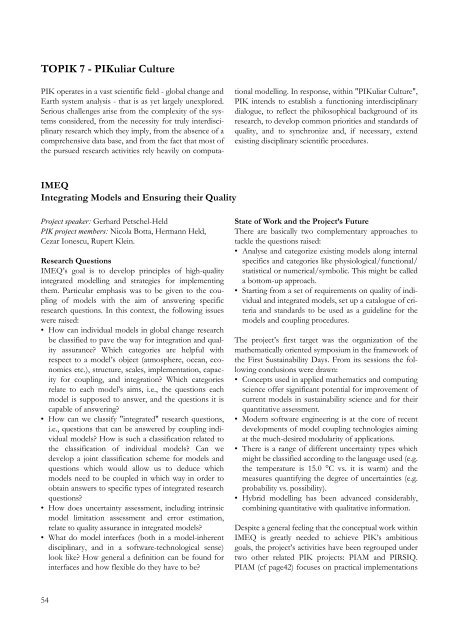PIK Biennial Report 2000-2001 - Potsdam Institute for Climate ...
PIK Biennial Report 2000-2001 - Potsdam Institute for Climate ...
PIK Biennial Report 2000-2001 - Potsdam Institute for Climate ...
You also want an ePaper? Increase the reach of your titles
YUMPU automatically turns print PDFs into web optimized ePapers that Google loves.
TO<strong>PIK</strong> 7 - <strong>PIK</strong>uliar Culture<br />
<strong>PIK</strong> operates in a vast scientific field - global change and<br />
Earth system analysis - that is as yet largely unexplored.<br />
Serious challenges arise from the complexity of the systems<br />
considered, from the necessity <strong>for</strong> truly interdisciplinary<br />
research which they imply, from the absence of a<br />
comprehensive data base, and from the fact that most of<br />
the pursued research activities rely heavily on computa-<br />
IMEQ<br />
Integrating Models and Ensuring their Quality<br />
Project speaker: Gerhard Petschel-Held<br />
<strong>PIK</strong> project members: Nicola Botta, Hermann Held,<br />
Cezar Ionescu, Rupert Klein.<br />
Research Questions<br />
IMEQ’s goal is to develop principles of high-quality<br />
integrated modelling and strategies <strong>for</strong> implementing<br />
them. Particular emphasis was to be given to the coupling<br />
of models with the aim of answering specific<br />
research questions. In this context, the following issues<br />
were raised:<br />
• How can individual models in global change research<br />
be classified to pave the way <strong>for</strong> integration and quality<br />
assurance? Which categories are helpful with<br />
respect to a model’s object (atmosphere, ocean, economics<br />
etc.), structure, scales, implementation, capacity<br />
<strong>for</strong> coupling, and integration? Which categories<br />
relate to each model’s aims, i.e., the questions each<br />
model is supposed to answer, and the questions it is<br />
capable of answering?<br />
• How can we classify "integrated" research questions,<br />
i.e., questions that can be answered by coupling individual<br />
models? How is such a classification related to<br />
the classification of individual models? Can we<br />
develop a joint classification scheme <strong>for</strong> models and<br />
questions which would allow us to deduce which<br />
models need to be coupled in which way in order to<br />
obtain answers to specific types of integrated research<br />
questions?<br />
• How does uncertainty assessment, including intrinsic<br />
model limitation assessment and error estimation,<br />
relate to quality assurance in integrated models?<br />
• What do model interfaces (both in a model-inherent<br />
disciplinary, and in a software-technological sense)<br />
look like? How general a definition can be found <strong>for</strong><br />
interfaces and how flexible do they have to be?<br />
54<br />
tional modelling. In response, within "<strong>PIK</strong>uliar Culture",<br />
<strong>PIK</strong> intends to establish a functioning interdisciplinary<br />
dialogue, to reflect the philosophical background of its<br />
research, to develop common priorities and standards of<br />
quality, and to synchronize and, if necessary, extend<br />
existing disciplinary scientific procedures.<br />
State of Work and the Project’s Future<br />
There are basically two complementary approaches to<br />
tackle the questions raised:<br />
• Analyse and categorize existing models along internal<br />
specifics and categories like physiological/functional/<br />
statistical or numerical/symbolic. This might be called<br />
a bottom-up approach.<br />
• Starting from a set of requirements on quality of individual<br />
and integrated models, set up a catalogue of criteria<br />
and standards to be used as a guideline <strong>for</strong> the<br />
models and coupling procedures.<br />
The project’s first target was the organization of the<br />
mathematically oriented symposium in the framework of<br />
the First Sustainability Days. From its sessions the following<br />
conclusions were drawn:<br />
• Concepts used in applied mathematics and computing<br />
science offer significant potential <strong>for</strong> improvement of<br />
current models in sustainability science and <strong>for</strong> their<br />
quantitative assessment.<br />
• Modern software engineering is at the core of recent<br />
developments of model coupling technologies aiming<br />
at the much-desired modularity of applications.<br />
• There is a range of different uncertainty types which<br />
might be classified according to the language used (e.g.<br />
the temperature is 15.0 °C vs. it is warm) and the<br />
measures quantifying the degree of uncertainties (e.g.<br />
probability vs. possibility).<br />
• Hybrid modelling has been advanced considerably,<br />
combining quantitative with qualitative in<strong>for</strong>mation.<br />
Despite a general feeling that the conceptual work within<br />
IMEQ is greatly needed to achieve <strong>PIK</strong>’s ambitious<br />
goals, the project’s activities have been regrouped under<br />
two other related <strong>PIK</strong> projects: PIAM and PIRSIQ.<br />
PIAM (cf page42) focuses on practical implementations

















